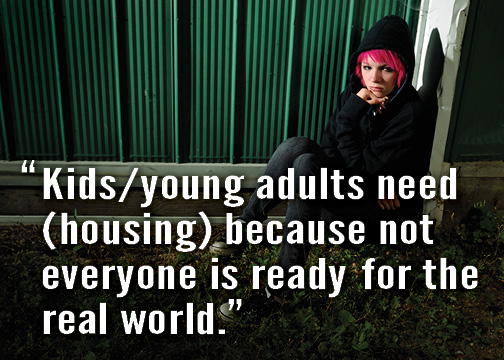
| The Connecting YOUth Project The Connecting YOUth Project seeks to end homelessness for New Jersey youth currently or previously involved in the child welfare system and assist their successful transition to adulthood. Informed by youth, community partners, scientific research, and data, Connecting YOUth promotes positive core outcomes for these youth by addressing their well-being, permanency, housing, education, and employment needs. Connecting YOUth is engaged in a two-phase effort to (1) research the needs of New Jersey's homeless youth and inventory current services that aim to |
|
|
end youth homelessness, and (2) create a plan to develop and deploy services to end youth homelessness specific to the identified needs of New Jersey's homeless youth. |
 |
DCF Youth at Risk Homeless Project Overview: Connecting YOUth Phase I.
We completed a statewide analysis and assessment of the needs of homeless New Jersey youth and New Jersey youth aging out of care and the services available to them. Informed by this research, we developed an intervention framework based on a model from the U. S. Interagency Council on Homelessness. This framework is to provide a holistic approach to ensure housing stability, permanency, well-being, educational, and employment resources are readily available to:
- youth between 14 and 17 years of age who enter, or are in, the child welfare system;
- youth between 18 and 21 aging out of the system; and
- youth up to 21 previously in the system and now homeless.
Planning activities and accomplishments include:
Findings and Data
Synthesizing the data collected during Phase I, Connecting YOUth shared its findings with DCF's partners and other programs so they, too, can benefit from the insight and better serve homeless youth.
Newsletters
Phase I is funded by a nearly $715,000, two-year (2013-2015) federal grant.
DCF Youth at Risk Homeless Project Overview: Connecting YOUth Phase II.
Phase I identified the extent individual promotive factors (factors that both mitigate risk and enhance healthy development and well-being for youth) and risk factors (factors that jeopardize a child's prospects for a secure life) are uniquely present among New Jersey homeless youth, providing a picture of youth most at-risk for homelessness.
In Phase II Connecting YOUth developed and proposed a comprehensive three-prong intervention package providing age-appropriate services and support tailored to the specific needs of New Jersey's homeless youth. This package addresses education, housing, and permanency services and is aligned with the U.S. Interagency Council on Homelessness' framework.
The plan seeks to expand and improve youth housing options and program model capacities to meet the needs of homeless youth, enhance training for local offices and service providers, and employ new screening and assessment tools. The proposal also recommends reallocating funds, restructuring Chafee services, and strengthening community partnerships to better coordinate and offer services and supports.
Phase 2 is funded by a three-year (2015 to 2018) federal grant.

*The quotes above are directly from youth who participated in DCF's YARH Connecting Youth Phase I













